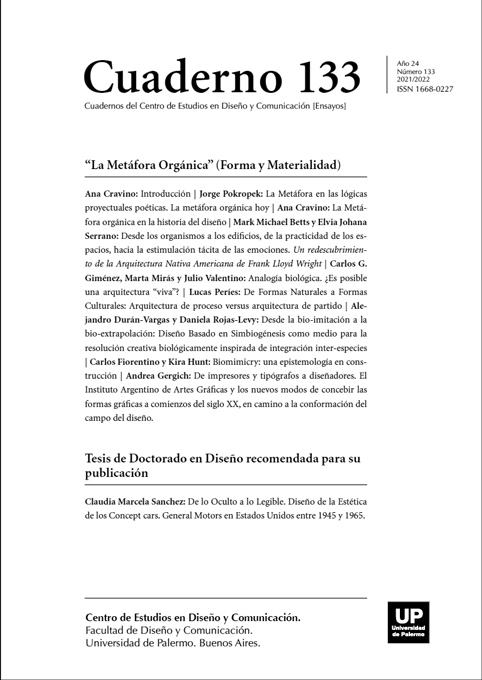Desde los organismos a los edificios, de la practicidad de los espacios, hacia la estimulación tácita de las emociones.
Abstract
At the end of the 19th century, specifically in the contexts of the United States and Europe, the emergence of ruptures around the conception of the artifactual became increasingly evident. The urgency of the professionals attached to the design disciplines to base their practices on a foundation that did not come from the meanings of the art of the time, became a kind of categorical imperative. When designers became interested in other sources of knowledge to ground their theories, the concepts of beauty and functionality, subject for decades to the conception of shape (forms), were finally divorced. In order to constitute methods that would help them distance themselves from subjectivity, and that would bring Design and Architecture closer to the knowledge and observational practices of the sciences, designers opened the way to the appropriateness of analogies. Although the intelligible processes they sought to establish pursued a kind of objectivity of functions, their attempts were valued, and at the same time criticized as a utopian task to achieve. The critical, comparative and interpretative analysis between the works that seemed to materialize such processes and the criticisms that accuse their absence are presented to question their lack or lack of coherence.
References
Betts, M. (2020). Divergencias en torno al concepto de Funcionalismo en la XSSX XXdel Diseño. Primera Escuela de Chicago, Bauhaus y HfG, Hochschule für Gestaltung. Buenos Aires: Universidad de Palermo. Recuperado el 27 de marzo de 2021, de: https://www.palermo.edu/dyc/doctorado_diseno/documentacion/Tesis_Betts.pdf
Collins, P. (1970/1998). Los Ideales de la Arquitectura Moderna; Su Evolución (1750-1950). Barcelona: Gustavo Gili.
De Zurko, E. R. (1957/1970). La Teoría del Funcionalismo en la Arquitectura. Buenos Aires: Nueva Visión.
Johnson, H.F. Jr. (2020) Diseñado para inspirar: El edificio administrativo diseñado por Frank Lloyd Wright de SC Johnson. SC Johnson. A family Company at work for a better world. Recuperado el 28 de marzo de 2021 de: https://www.scjohnson.com/es/a-family-company/architecture-and-tours/frank-lloyd-wright/designed-to-inspire-sc-johnsons-frank-lloyd-wright-designed-administration-building
Koselleck, R. (1993). Futuro Pasado. Barcelona: Paidós.
Koselleck, R. (2004). Historia de los Conceptos y Conceptos de Historia. Revista Ayer: 53. Recuperado el 20 de junio de 2020, de: http://www.ahistcon.org/PDF/numeros/ayer53_HistoriaConceptos_Fernandez_Fuentes.pdf
Koselleck, R. (2012). Historias de conceptos. Estudios sobre semántica y pragmática del lenguaje político y social. Madrid: Trotta. Publicado originalmente en Alemania en el año 2006.
RAE. Real Academia Española (2021). Definición del concepto analogía. Recuperado el 28 de marzo de 2021 de: https://dle.rae.es/analog%C3%ADa?m=form
Skinner, Q. (2000). Significado y comprensión en la historia de las ideas. Prismas. Revista de Historia Intelectual, núm. 4, pp. 149-191.
Wright, F. Y. (1953). The Future of Architecture. New York: Horizon Press.
Wright, F. Y. (1957/1961). A Testament. New York: Horizon Press.
Los autores/as que publiquen en esta revista ceden los derechos de autor y de publicación a "Cuadernos del Centro de Estudios de Diseño y Comunicación", Aceptando el registro de su trabajo bajo una licencia de atribución de Creative Commons, que permite a terceros utilizar lo publicado siempre que de el crédito pertinente a los autores y a esta revista.


